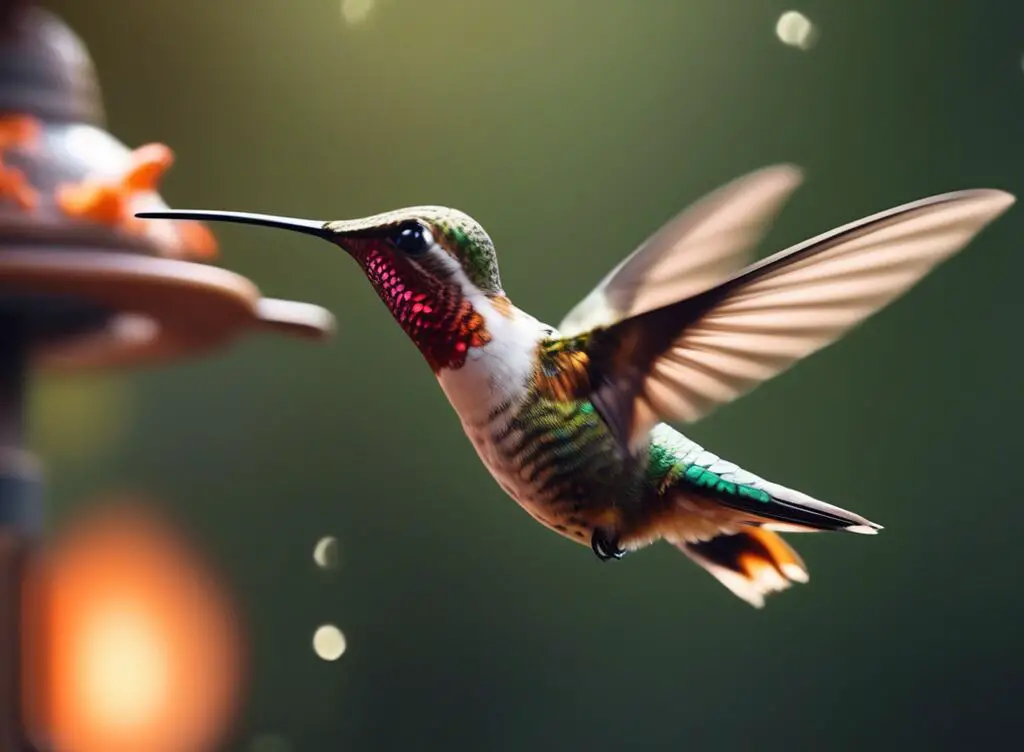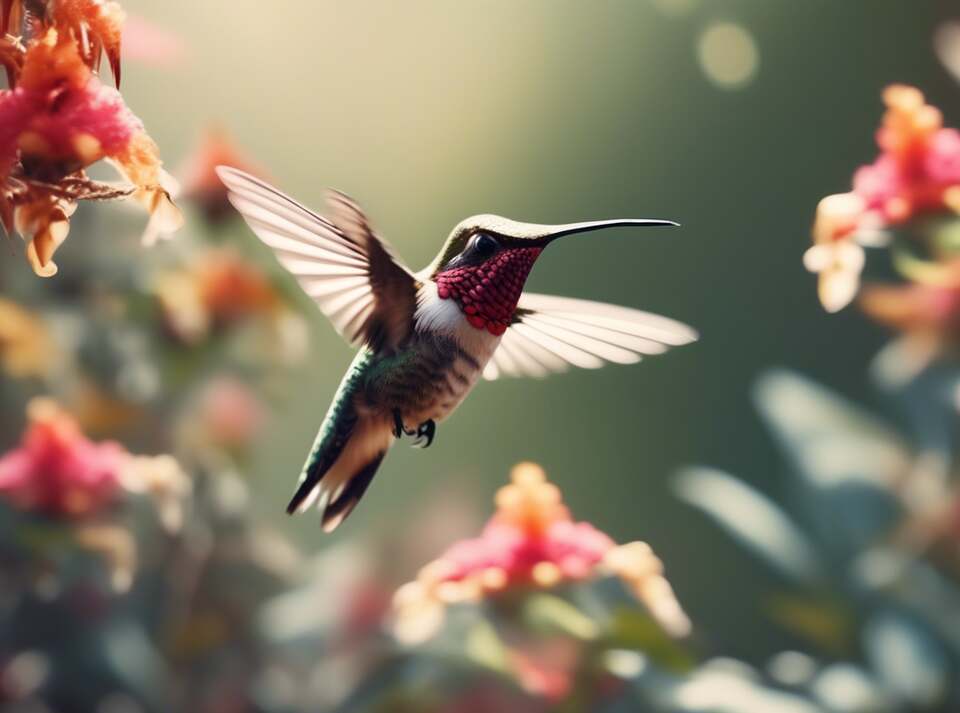Hummingbirds are fascinating creatures known for their unique ability to hover in mid-air. Have you ever wondered how these tiny birds manage to stay perfectly still while flapping their wings incredibly fast? Let’s delve into the mechanics behind how hummingbirds achieve this remarkable feat.
Table of Contents
How Do Hummingbirds Hover?
The Anatomy of Hovering
Hummingbirds have evolved several adaptations that enable them to hover with such precision. Their wings are incredibly flexible and can be rotated in a figure-eight pattern, allowing them to generate lift on both the forward and backward strokes. This specialized wing motion creates lift on both the upstroke and the downstroke, unlike other birds that only generate lift on the downstroke.
Rapid Wingbeat
One of the key factors that enable hummingbirds to hover is their rapid wingbeat. These birds have an average wingbeat frequency of around 50 to 80 beats per second, enabling them to stay airborne without moving forward. This swift wing movement creates enough lift to counteract gravity, keeping the hummingbird suspended in the air.
Energy Efficiency
Despite their high metabolic rate, hummingbirds are incredibly energy-efficient when it comes to hovering. They have the highest metabolic rate of any bird species, but they can conserve energy by entering a state of torpor at night or during periods of food scarcity. Torpor is a state of reduced metabolic activity that allows hummingbirds to conserve energy when food sources are limited.
Aerodynamic Design
The aerodynamic design of a hummingbird’s body is crucial for achieving stable hovering. Their small size and streamlined shape reduce air resistance, allowing them to move through the air with minimal drag. Additionally, their ability to adjust the angle of their wings and tail feathers helps them maintain balance and control while hovering.
Hovering Techniques
Hummingbirds employ a combination of body movements to maintain stability while hovering. They adjust the angle of their wings, tail feathers, and body position to counteract wind gusts or changes in air currents. By making rapid adjustments in real-time, hummingbirds can remain stationary in mid-air despite external disturbances.
Feeding Behavior
Hovering plays a crucial role in a hummingbird’s feeding behavior. These birds rely on nectar as their primary food source, and hovering allows them to extract nectar from flowers with precision. By hovering in front of a flower, hummingbirds can extend their long, specialized beak into the flower to access the sugary nectar inside.
The ability of hummingbirds to hover is a remarkable adaptation that sets them apart from other bird species. Through a combination of rapid wingbeats, specialized anatomy, and aerodynamic design, hummingbirds can achieve stable hovering with incredible precision. Studying how hummingbirds hover not only provides insights into their fascinating behavior but also offers valuable lessons in aerodynamics and biomechanics.
The Unique Feeding Habits of Hummingbirds
Unveiling the Fascinating Feeding Habits of Hummingbirds
Hummingbirds are among the most captivating and unique birds in the avian world. Their distinctive feeding habits set them apart from other bird species, making them a subject of fascination for bird enthusiasts and nature lovers alike. In this article, we delve into the mesmerizing world of hummingbirds and explore the intricacies of their feeding behavior.
The Hovering Feat
One of the most remarkable abilities of hummingbirds is their capability to hover in mid-air. Unlike other birds that must perch or land to feed, hummingbirds can remain suspended in the air while sipping nectar from flowers. This extraordinary feat is made possible by the rapid flapping of their wings, which can beat up to 80 times per second. As they hover, hummingbirds exhibit remarkable agility and precision, allowing them to navigate through dense foliage with ease.
Feeding on Nectar
Hummingbirds are primarily nectarivores, which means that their diet consists mainly of nectar from flowers. To extract nectar, hummingbirds use their specialized long, slender bills and grooved tongues. As they feed, they extend their bifurcated tongues deep into flowers, lapping up the sugary liquid with astonishing efficiency. The high sugar content of nectar provides hummingbirds with the energy they need to sustain their rapid metabolism and constant wing flapping.
Supplementing their Diet
In addition to nectar, hummingbirds also supplement their diet with insects and spiders. These tiny creatures provide essential proteins and nutrients that nectar alone may not fully supply. To catch insects, hummingbirds perform impressive aerial acrobatics, darting and diving to capture their prey mid-flight. This opportunistic feeding behavior demonstrates the adaptability and resourcefulness of these remarkable birds.
Energy Expenditure
The hovering and rapid wing flapping of hummingbirds require a tremendous amount of energy. To sustain their high metabolic rate, hummingbirds must feed multiple times per hour. In fact, some species of hummingbirds consume up to half their body weight in nectar each day. This constant need for energy drives hummingbirds to seek out nectar-rich flowers and defend their feeding territories from competitors.
Migration and Feeding Ecology
During migration, hummingbirds undertake long journeys spanning thousands of miles. To prepare for these arduous flights, hummingbirds enter a phase known as hyperphagia, where they increase their food intake significantly to store fat reserves. This period of hyperphagia is crucial for providing hummingbirds with the energy reserves needed to sustain their migratory flights.
Conservation Importance
Understanding the feeding habits of hummingbirds is essential for their conservation. As vital pollinators, hummingbirds play a crucial role in maintaining the health of ecosystems by facilitating the reproduction of flowering plants. By protecting the habitats of hummingbirds and the flowers they depend on, we can ensure the continued survival of these remarkable birds for generations to come.
The unique feeding habits of hummingbirds offer a glimpse into the intricate relationship between these tiny birds and the natural world. Their remarkable hovering ability, nectar-feeding behavior, and agile hunting skills showcase the incredible adaptations that have allowed hummingbirds to thrive in diverse environments. By appreciating and safeguarding the feeding habits of hummingbirds, we can contribute to the preservation of these extraordinary creatures and the ecosystems they inhabit.
Conclusion
In understanding how hummingbirds hover, we unveil nature’s magnificent engineering marvel. These tiny creatures have perfected the art of sustained hovering through a combination of rapid wing movements, specialized anatomy, and unique flight techniques. By beating their wings in a figure-eight pattern, rotating their wing joints, and utilizing their powerful chest muscles, hummingbirds generate enough lift to remain stationary mid-air, mesmerizing us with their agility and grace.
Moreover, exploring the unique feeding habits of hummingbirds sheds light on their extraordinary adaptability. These avian wonders have evolved to depend heavily on flower nectar as their primary energy source. By consuming up to double their body weight in nectar each day, hummingbirds showcase their remarkable metabolism and foraging skills. Their long, specialized bills and extendable, forked tongues enable them to access nectar hidden within intricate floral structures, making them vital pollinators in various ecosystems.
As we delve deeper into the world of hummingbirds, we discover a diverse and fascinating species that continues to captivate researchers and nature enthusiasts alike. From their astounding aerial feats to their symbiotic relationship with flowering plants, hummingbirds exemplify the intricate balance of nature and the marvels that await those who observe and appreciate the wonders of the natural world. Whether studying their hovering techniques or marveling at their iridescent plumage, each encounter with these miniature marvels offers a glimpse into the beauty and complexity of our planet’s biodiversity.
The mesmerizing ability of hummingbirds to hover effortlessly is a testament to the wonders of evolution and adaptation. Their specialized feeding habits, fueled by a relentless quest for nectar, showcase nature’s intricate interconnectedness and the vital role these tiny birds play in sustaining diverse ecosystems. By unraveling the mysteries of how hummingbirds hover and exploring their unique dietary preferences, we gain a deeper appreciation for the complexity and resilience of these avian gems.
So, next time you catch a glimpse of a hummingbird darting gracefully from flower to flower, take a moment to marvel at the extraordinary capabilities and remarkable behaviors that make these tiny creatures such a cherished part of our natural world.



